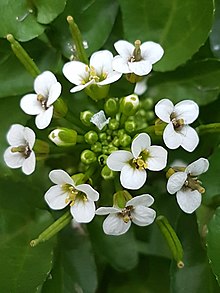| Watercress | |
|---|---|

| |
| Leaves | |

| |
| Flowers | |
| Scientific classification | |
| Kingdom: | Plantae |
| Clade: | Tracheophytes |
| Clade: | Angiosperms |
| Clade: | Eudicots |
| Clade: | Rosids |
| Order: | Brassicales |
| Family: | Brassicaceae |
| Genus: | Nasturtium |
| Species: | N. officinale
|
| Binomial name | |
| Nasturtium officinale | |
| Synonyms[2] | |
|
Synonymy
| |

Watercress or yellowcress (Nasturtium officinale) is a species of aquatic flowering plant in the cabbage family, Brassicaceae.
Watercress is a rapidly growing perennial plant native to Europe and Asia. It is one of the oldest known leaf vegetables consumed by humans. Watercress and many of its relatives, such as garden cress, mustard, radish, and wasabi, are noteworthy for their piquant flavors.
The hollow stems of watercress float in water. The leaf structure is pinnately compound. Small, white, and green inflorescences are produced in clusters and are frequently visited by insects, especially hoverflies, such as Eristalis flies.[3]
- ^ Ghogue, J.-P.; Akhani, H. & Zehzad, B. (2020). "Nasturtium officinale". IUCN Red List of Threatened Species. 2020: e.T164311A136666515. Retrieved 21 May 2022.
- ^ The Plant List, Nasturtium officinale R.Br.
- ^ Van Der Kooi, C. J.; Pen, I.; Staal, M.; Stavenga, D. G.; Elzenga, J. T. M. (2016). "Competition for pollinators and intra-communal spectral dissimilarity of flowers" (PDF). Plant Biology. 18 (1): 56–62. doi:10.1111/plb.12328. PMID 25754608.
